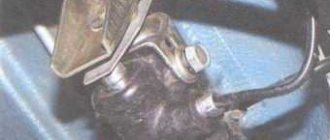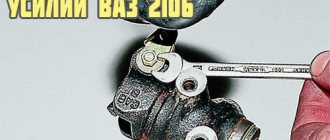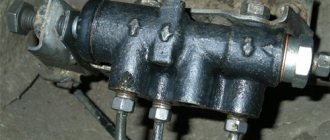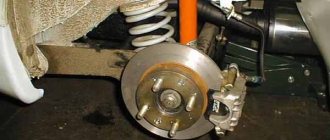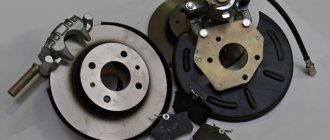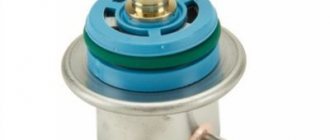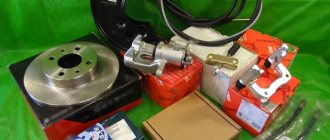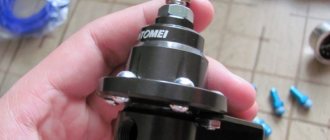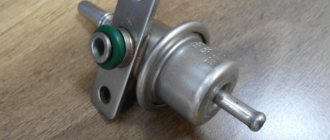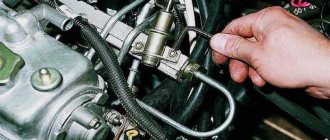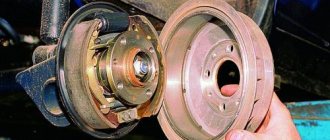- In simple words
With heavy words
Where is the brake pressure regulator on a VAZ?
On many VAZ cars, the sorcerer is located mainly in the rear of the car, but so that you understand immediately and in the future you do not have questions about this, we note that on VAZ cars with the ABS system the sorcerer is not installed.
If we take cars of modern production, such as: “Priora”, “Kalina”, “Granta” as well as “VAZ 2108-VAZ 2115” and other modern cars, then on them the sorcerer is mainly located on the left side, the detailed location of the sorcerer is indicated in the photo below:
If you take cars of the classic family, people also call them “Classics”, then on them the sorcerer is located in the right rear part of the car body, see the photo below for more details:
Note! The location of the sorcerer is indicated by the number “1”!
When do you need to change the brake pressure regulator on a VAZ?
Usually, when it fails, the car begins to pull to the side when braking sharply. But with a working regulator, this is no longer observed and the car slows down exactly along its trajectory.
But even with a working regulator, the car can go into a skid during sharp braking, and why you ask! Yes, because in some cases, for the regulator to work properly, it simply needs to be adjusted.
Note! The regulator will need to be adjusted under the following circumstances: Firstly, if the car's shock absorbers or springs were replaced with new ones, and also if the rear suspension beam was changed or simply removed. Simply put, it is subject to adjustment for any significant changes in the vehicle's ground clearance!
How does the brake pressure regulator work when braking a car?
In simple words: When you press the brake pedal sharply, the rear of the car rises and the front lowers, and in connection with this the sorcerer begins its work. After the sorcerer has started working, he thereby prevents the rear wheels of the car from immediately starting to brake after pressing the pedal, but why is this necessary?
The whole point is that if the rear wheels of the car start to brake at the same time as the front wheels, then there will be a very high probability that the car will skid. And if the rear wheels of the car work with a slight delay, then in such a situation there will be much less chance that the car will skid.
Note! You can also study the sorcerer’s work in more detail in the video clip that you will find at the very bottom of the article!
In heavy words: When a car brakes, in the rear part of the car the distance between the bottom and the rear axle of the car increases. While the distance increases, the lever from the bridge releases the piston that is located in the sorcerer and thereby this piston blocks the access of brake fluid to the rear wheels. What will happen if access to brake fluid to the rear wheels is blocked? Everything is simple, the wheels will not block but will continue to spin.
Note! But in the regulator itself there is also a small spring, thanks to which the piston does not block all the brake fluid, but only part of it, and in connection with this, the rear wheels of the car will still slow down, but will not be completely blocked!
How to replace and adjust the brake pressure regulator on a VAZ?
- How to replace and adjust the sorcerer on cars of the Samara family?
Additional video: Do you need a brake pressure regulator or not? If you are interested in this, then watch the video below:
Adjusting the braking forces of Lada Vesta
The operating principle of the system that regulates and distributes brake fluid pressure on Lada Vesta cars is fundamentally different from previous models, and there is no “witchcraft” in it. The Lada Vesta brake pressure regulator is directly connected to the ABS system and is electronically regulated depending on the speed of each wheel.
The ABS control unit transmits signals from speed sensors and analyzes the situation. The system “understands” any skidding and allows you to distribute the braking force with maximum efficiency. The pressure is controlled by the valves in the ABS hydraulic block, and there is no need for any magic. In addition, the electronics itself detects all malfunctions and reports them to the driver using a special lamp on the dashboard.
checking and adjusting brakes on VAZ 2110 VAZ 2111 VAZ 2112 cars
Checking pipelines and connections To prevent sudden failure of the brake system of the VAZ 2110, VAZ 2111, VAZ 2112, carefully check the condition of all pipelines and connections, paying attention to the following: metal pipelines should not have nicks, scratches, burrs, active foci of corrosion and should be located away from from sharp edges that can damage them;
brake hoses must not have any cracks on the outer shell or signs of chafing visible to the naked eye; they should not be exposed to mineral oils and lubricants that dissolve rubber; by pressing the brake pedal firmly, check to see if any swelling appears on the hoses, indicating their destruction; all pipeline fastening brackets must be intact and well secured; loosening or destruction of brackets leads to vibration of pipelines, causing their breakdowns; Do not allow fluid to leak from the connections of the master cylinder with the tank and pipelines; if necessary, replace the tank bushings and tighten the nuts without subjecting the pipelines to deformation. When tightening the pipeline nuts, use the wrench 67.7812.9525. Eliminate any detected faults by replacing damaged parts with new ones. Flexible hoses, regardless of their condition, should be replaced with new ones after 125 thousand kilometers or after five years of operation of a VAZ 2110, VAZ 2111, VAZ 2112 to prevent sudden ruptures due to aging.
Checking the functionality of the vacuum booster VAZ 2110, VAZ 2111, VAZ 2112
Press the brake pedal 5-6 times with the engine off to create equal pressure close to atmospheric in cavities A and B (see Fig. 6-2). At the same time, by the force applied to the pedal, make sure that the valve body is not jammed. Keep the brake pedal depressed and start the engine. If the vacuum booster of the VAZ 2110, VAZ 2111, VAZ 2112 is in good working order, the brake pedal should “move forward” after starting the engine. If the brake pedal does not “go forward”, check the fastening of the hose tip, the condition and fastening of the tip flange in the booster, the hose to the tip and the fitting of the engine intake pipe, since loosening the fastening or their damage sharply reduces the vacuum in cavity A and the efficiency of the booster.
rice.
6-2. Vacuum booster: 1 - vacuum booster housing; 2 — amplifier housing cup; 3 - rod; 4 — adjusting bolt; 5 — rod seal; 6 — sealing ring of the main cylinder flange 7 — diaphragm return spring; 8 — amplifier pin; 9 — tip mounting flange; 10 - valve; 11 — hose tip; 12 - diaphragm; 13 — amplifier housing cover; 14 — sealing cover; 15 - piston; 16 — protective cover of the valve body; 17 — air filter; 18 — pusher; 19 — pusher return spring; 20 — valve spring; 21 - valve; 22 — valve body bushing; 23 — rod buffer; 24 — valve body; A - vacuum chamber; B - atmospheric chamber; C, D - channels Adjusting the brake drive of VAZ 2110, VAZ 2111, VAZ 2112
The free play of the brake pedal when the engine is not running should be 3-5 mm. The adjustment is carried out by moving the brake light switch 7 (Fig. 6-11) with nut 6 released. Install the switch so that its buffer rests against the pedal stop, and the free play of the pedal is 3-5 mm. In this position of the switch, tighten nut 6.
rice.
6-11. Brake drive: 1 — master cylinder; 2 - tank; 3 - vacuum booster; 4 — brake pedal bracket; 5 — brake light switch buffer; 6 — brake light mounting nut; 7 — brake light switch; 8 - brake pedal WARNING Adjust the free play of the brake pedal when the engine of the VAZ 2110, VAZ 2111, VAZ 2112 is not running. If the brake light switch is too close to the pedal, it does not return to its original position.
In this case, valve 21 (see Fig. 6-2), pressing against body 24, separates cavities A and B, which opens air access to chamber B, and the wheels are incompletely released when the pedal is released. If moving the brake light switch cannot eliminate the incomplete release of the brake mechanisms, then disconnect the brake master cylinder from the vacuum booster and check the protrusion of the adjusting bolt 4 relative to the mounting plane of the master cylinder flange (size 1.25-0.2 mm). This size can be set by holding the end of the rod with a special wrench, and with another wrench, tightening or unscrewing bolt 4.
Description of design
The service brake system is hydraulic, dual-circuit (with diagonally separated circuits), with a pressure regulator 10, a vacuum booster 5 and an indicator of insufficient brake fluid level in the reservoir. If one of the brake system circuits fails, the second circuit provides braking of the vehicle, although with less efficiency.
The brake mechanisms of the front wheels 13 are disc, with a single-piston floating caliper. Currently, brake pads are available with a mechanical (acoustic) or electrical wear indicator. At the factory, cars are equipped with pads without a wear indicator or with an electric indicator (if a control unit is installed on the car).
The brake mechanisms of the rear wheels 7 are drums, with two-piston wheel cylinders and automatic adjustment of the gap between the shoes and the drum. The automatic clearance adjustment device is located in the wheel cylinder.
The main brake cylinder 1 is attached to the housing of the vacuum booster 5 on two studs. A translucent polyethylene brake reservoir 4 with an insufficient fluid level sensor is inserted into the holes in the upper part of the cylinder on rubber seals. The tank has markings for maximum and minimum fluid levels. Two screws are screwed into the bottom of the cylinder to limit the movement of the pistons. The screws are sealed with copper gaskets. A plug is screwed into the front part of the cylinder (along the direction of the car), which serves as a stop for the return spring and is sealed with a copper gasket. The pistons in the master cylinder are located in series, the one closest to the vacuum booster operates the left front and right rear brake mechanisms, and the one closer to the plug operates the right front and left rear. The high-pressure rubber sealing rings (cuffs) of the master cylinder and rear wheel cylinders are interchangeable (nominal diameter 20.64 mm). The low pressure sealing ring is grooved, installed on the piston in contact with the vacuum booster rod.
Vacuum booster 5 is located between the pedal assembly and the main brake cylinder 1 and is attached to a bracket, which, in turn, is fixed to the front panel of the body on four welded studs. The amplifier is of a non-demountable design; if it fails, it is replaced. The simplest way to check the serviceability of the amplifier: on a car with the engine turned off, press the brake pedal several times and, holding it down, start the engine. If the amplifier is working properly, after starting the engine the pedal should move forward. Failure to operate or insufficient efficiency of the vacuum booster may be caused by a leak in the vacuum supply hose from the intake manifold.
The purpose of the sorcerer
Where is the oil pressure sensor on the Kamaz
? The so-called sorcerer on the VAZ-2109 is necessary to automatically change the fluid pressure in the rear brake cylinders depending on the load acting on the car when the speed decreases. This element is used in both hydraulic and pneumatic drive systems.
The main purpose of changing the pressure is to prevent possible wheel locking and skidding of the rear axle of the car.
In some car models, in order to maintain their controllability and stability, a regulator is additionally installed in the brake drive of the front wheels.
In addition, on the VAZ-2109 the sorcerer is used to increase the braking efficiency of an empty car. The traction force of a loaded car and an empty one is different, so the force on different axles must be adjusted. In the case of a loaded and empty machine, static type regulators are used. Automatic solutions are installed in trucks.
In sports cars, manufacturers often install a screw adjuster. It is located inside the car and adjusts the balance of the brake system directly during the race. It is adjusted based on weather conditions, road conditions, and tire quality.
From dual-circuit-diagonal to dual-circuit-axial
The figure shows a diagram of the VAZ 2110 brakes. In the VAZ dual-circuit diagonal diagram, 2 pipes go to the rear brake mechanisms. To make the system a dual-circuit-axial one, one of the tubes going backwards on the master cylinder (GTC) must be plugged (with a ball from the bearing). The “sorcerer” can be left, muting the current circuit, as in the diagram. Or install a tee instead of a “sorcerer”. In both cases we get uniform brakes on the rear axle. Effect: The brakes become sharper because all 4 wheels begin to brake with the same maximum force.
Basic faults and brake repair options
KamAZ GTK for cab
The best fix is prevention. When operating the VAZ 2108, it is necessary to strictly adhere to the scheduled maintenance periods for the brake system. This applies to the friction linings of the front disc and rear drum brakes. Complete wear of the friction linings threatens unexpected brake failure in an extreme situation. Periodically check the condition of the linings, monitor their level of wear, and replace if necessary.
Carefully monitor the brakes of the VAZ 2108 in terms of fluid leakage through worn gaskets and seals. Excessive wear of the sealing elements is fraught with the risk of insufficient force in the brake cylinders, failure of the pedal when driving the VAZ 2108, and an increase in the braking distance. All this creates very serious risks. Brakes are a critical safety system for drivers, passengers and other road users.
The principle of operation of a brake caliper and why it is needed at all
Welcome! A brake caliper is essentially a very necessary thing, since practically no car can do without it, because the brake caliper does the most basic work during braking, but not all people know how it works and what will happen if it doesn’t installed on the car, that’s what we’ll look at today.
Note! At the end, in addition to this article, there is an interesting video clip that shows the entire principle of operation of the brake system!
What is a caliper for and what is its operating principle?
In short, it is needed so that the car slows down when you press the brake pedal and if it is not there, as was said earlier, the car will not stop at all, since the main work of braking is performed by this particular caliper.
Well, if we talk in more detail and, in addition to all this, delve into the principle of its operation, then this very principle of its operation is as follows: when you press the brake pedal, pressure occurs in the brake system, namely the piston which is located in the master brake cylinder ( This cylinder is indicated by the number 3), moves from the beginning of this cylinder to the end, thereby still collecting a little brake fluid that is in the brake reservoir (indicated by the number 5), squeezing the brake fluid forward, it goes through the hoses and thereby squeezes out the pistons that are in the caliper itself, and these pistons press on the brake pads and the car stops.
Let's look at it in more detail, for this let's first look at what this main brake cylinder is, and it represents a structure inside which there is that same piston as well as a rod that presses on it, so when you have to stop the car, you press accordingly on the brake pedal, after pressing the rod will also mix forward, thereby the piston that sits on this rod will mix, and after mixing, all the brake fluid will be pushed forward, as it were, and it will go all the way to the working cylinders themselves, which we will talk about a little lower.
Note! Let us tell you right away so that you understand one thing, this brake fluid is not compressible, so if something does not press on it, it will also press on other parts of the brake system and at the same time it will not compress!
Now the fluid will press from one end, onto all working cylinders to which hoses are connected (Hoses that are connected to the working cylinders are indicated by numbers 2 and 4 in the photo above, which shows a diagram of the brakes of a VAZ 2110 car), so after the brake fluid is the working cylinder is filled, the piston which is located in this cylinder will be squeezed out and thereby put pressure on the brake pad, and the brake pad at this moment will compress the brake disc and therefore friction will occur which stops the car.
And in conclusion, let’s note why a car needs a brake reservoir, namely, thanks to the brake reservoir, which contains the fluid itself and maintains the normal level of this fluid in the system, to understand more, look at the photo located just below:
Where is the brake caliper located?
On many cars it is different, sometimes this caliper is located in the front part of the car, and sometimes in the front and rear at the same time, and on some cars (Mainly on old ones) there were usually no brake calipers at all, and instead of them ordinary drum brakes were used , and these brakes heat up very quickly and therefore the effectiveness of their braking after constantly pressing the brake pedal (Especially in hot weather) greatly decreased and thus the number of accidents was not small.
Note! On domestically produced cars (VAZ), in most cases, the brake caliper is located only at the front of the car, and the rear wheels are equipped with conventional brake drums! (By the way, if you are interested and want to know how brake pads for disc and drum brakes work, then read an interesting article entitled: “What are brake pads and how not to run into a fake?”, everything is described in detail there)
Links! How to replace the front brake caliper - on a classic? How to replace the caliper on a VAZ 2108-VAZ 21099?
Additional video clip: You can learn more about how the brake system works in an interesting video clip located just below:
https://youtube.com/watch?v=Av-jj8NNrv8
Vaz-Russia.ru
How to check and adjust
Brake cleaner
If during the braking process the car slows down ineffectively, the car is pulled in one direction, the car often skids, then this is a signal that you need to check the unit and adjust the sorcerer on the VAZ-2109.
To check, the car is driven into a pit or overpass. Defects will be detected visually. Most often, the inspection shows that repair is not possible.
If we talk about adjustment, it is better to do it on an overpass. The adjustment greatly depends on the position of the body. Adjustments must be made after each maintenance. Adjustment is also necessary if something from the suspension has been changed. If there has been repair work on the rear beam or it has been changed, this also requires adjustment.
To adjust the device, use a wrench to slightly loosen the bolt securing the sorcerer to the lever. Then use a screwdriver to move the bracket until the gap allows you to insert a drill into it two millimeters. Next, the bolt needs to be tightened.
The regulator on the “ten” and previous models becomes very sour during the operation of the car. The bracket cannot be moved. In this situation, you can douse it with WD-40, and then use a hammer to move the part to the side.
VAZ 2115 Checking and adjusting brakes
6.3.1 Checking and adjusting the brakes
Checking pipelines and connections Checking the functionality of the vacuum booster Adjusting the brake drive Adjusting the parking brake system Checking the functionality of the pressure regulator on the car Removing air from the hydraulic drive Replacing brake fluid
6.3.2 Checking piping and connections
To prevent sudden failure of the brake system, carefully check the condition of all pipelines and connections, paying attention to the following: – metal pipelines should not have nicks, scratches, rubs, or active foci of corrosion and should be located away from sharp edges that could damage them; – brake hoses must not have any cracks visible to the naked eye..
6.3.8 Replacing brake fluid
To ensure that no air gets into the hydraulic drive system when replacing the brake fluid and that a minimum amount of time is spent on this operation, adhere to the following rules: - proceed in the same order as when bleeding the brakes, but use a hose with a glass tube at the end, which you lower into a container with brake fluid; – while pressing the brake pedal, pump out the old brake...
How to repair a car
So, in this article we will look in detail at how to replace the rear brake pressure regulator on VAZ-2170 Priora, VAZ-1118 Kalina, VAZ-2108, VAZ-2109, VAZ-21099, VAZ-2110
, VAZ-2115.
Reasons for replacing the rear brake pressure regulator
Replacement
The pressure regulator is made for several reasons, the main of which are: wear of the cuffs (when brake fluid leaks), souring of the sorcerer piston.
If you can check the brake fluid leakage by the level of the brake reservoir, then in the second case you will have to use someone's help.
Without a sorcerer
Knowing what the sorcerer's job is on the VAZ-2109, it is not difficult to guess what will happen if it is absent from the brake system. And the following will happen. The car will brake with all four wheels together. The wheels are blocked sequentially - first a pair of wheels on the rear axle, and then the front ones. The risk of an accident increases, since the driver moving behind is unlikely to react in time to a sudden maneuver. A collision will be inevitable.
A sorcerer in the car is very necessary. A VAZ-2109 car without a sorcerer can be very dangerous not only for others on the road, but also for the driver himself. This car is practically uncontrollable in a skid.
Only those who know exactly and understand well what they will get in the end remove the sorcerer. This is mostly done by professional racing drivers.
But some car owners still remove the sorcerer. At the same time, there are even claims that the car began to brake faster and better. Experts say it only seems so. In fact, everything is a little different. The problem here is that in the event of sudden braking, both pairs of wheels will jam in succession.
Messages 1 to 20 of 121
1 Topic by Kirey 2009-04-26 16:01:22
- Kirey
- User
- Offline
- Registered: 2009-02-03
- Messages: 376
- Reputation: [ 0 | 0 ]
Topic: Without the "sorcerer".
The question is: Has anyone gotten rid of the regulator? Instead, they install tees from the classics. The result is equal force on all wheels. Subscribe who did, saw, heard anything!
2 Reply from StreetGlow 2009-04-26 16:52:05
- StreetGlow
- User
- Offline
- Registered: 2008-11-10
- Messages: 227
- Reputation: [ 0 | 0 ]
Re: Without "sorcerer".
I heard they do. I think there will be excessive force on the rear wheels, because... Samara's backside is light. The wheels will be blocked.
3 Reply from Biker22rus 2009-04-26 20:56:49
- Biker22rus
- User
- Offline
- Registered: 2009-04-02
- Messages: 643
- Reputation: [ 0 | 0 ]
Re: Without "sorcerer".
I tried it, it doesn't work out well. Before you throw away this device, just try to press the adjustment plate tightly, it will have the same effect as without it.
4 Reply from ZipeR 2009-04-27 08:32:27
- ZipeR
- User
- Offline
- Registered: 2008-11-09
- Messages: 851
- Reputation: [ 0 | 0 ]
Re: Without "sorcerer".
It will be worse with standard brakes!
A friend removed it and it began to turn around when braking! it became normal when I put the ventel 15 forward and the stock 13 discs back!
5 Reply from Kirey 2009-05-12 08:40:34
- Kirey
- User
- Offline
- Registered: 2009-02-03
- Messages: 376
- Reputation: [ 0 | 0 ]
Re: Without "sorcerer".
I threw this sorcerer out! It seems to be slowing down, I just need to bleed it (I can’t find any help).
6 Reply from kamaz5310 2009-05-12 16:41:13
- kamaz5310
- User
- Offline
- Registered: 2008-12-06
- Messages: 997
- Reputation: [ 1 | 0 ]
Re: Without "sorcerer".
yy, they will fuck you for it)). Because making changes to the brake system is prohibited. Otherwise, it’s better without it; the plate always comes off the rod))
7 Reply from Kirey 2009-05-13 17:25:33
- Kirey
- User
- Offline
- Registered: 2009-02-03
- Messages: 376
- Reputation: [ 0 | 0 ]
Re: Without "sorcerer".
yy, they will fuck you for it)). Because making changes to the brake system is prohibited. Otherwise, it’s better without it; the plate always comes off the rod))
They won't fuck! This car will never pass so. 1000 rubles and a piece of paper in your pocket!
8 Reply from hahol_st 2009-05-14 01:08:28
- hahol_st
- User
- Offline
- Registered: 2009-03-29
- Messages: 395
- Reputation: [ 0 | 0 ]
Re: Without "sorcerer".
I threw this sorcerer out! It seems to be slowing down, I just need to bleed it (I can’t find any help).
I think there’s no need to joke with the brakes, my sorcerer wasn’t working (the rod sat dead in place), one front wheel was braking (it’s very bad to drive), the car spun during emergency braking. I replaced the sorcerer with a new one + converted it to a 2-circuit brake .system (there is a topic here), awesome ideas. So think carefully.
9 Reply from alexeykamf 2009-05-14 03:00:34
- alexeykamf
- User
- Offline
- Registered: 2008-11-09
- Messages: 1,679
- Reputation: [ 0 | 0 ]
Re: Without "sorcerer".
When he starts to throw his ass, say, at a speed of 100 km/h, he will think about a lot, he will even have time to remember his whole life.
10 Reply from Kirey 2009-05-15 16:39:19
- Kirey
- User
- Offline
- Registered: 2009-02-03
- Messages: 376
- Reputation: [ 0 | 0 ]
Re: Without "sorcerer".
When he starts to throw his ass, say, at a speed of 100 km/h, he will think about a lot, he will even have time to remember his whole life.
This morning, specifically after the above words, I accelerated to 100 km/h and braked sharply. Absolutely nothing was thrown anywhere or thrown away! They just braked all 4 wheels at once (by the way, they braked very well). And there is no need to scare people.
11 Reply from AMX 2009-05-15 16:40:58
- AMX
- User
- Offline
- Registered: 2008-12-11
- Messages: 389
- Reputation: [ 0 | 0 ]
Re: Without "sorcerer".
Are you trying to fool physics?
12 Reply from Kirey 2009-05-15 17:43:54
- Kirey
- User
- Offline
- Registered: 2009-02-03
- Messages: 376
- Reputation: [ 0 | 0 ]
Re: Without "sorcerer".
Please close this topic! I did what I wanted, but I didn’t find support.
13 Reply from alexeykamf 2009-05-17 05:42:16
- alexeykamf
- User
- Offline
- Registered: 2008-11-09
- Messages: 1,679
- Reputation: [ 0 | 0 ]
Re: Without "sorcerer".
First you have to grab the front and then grab the back! Suppose you brake even more or less normally on the asphalt, but in winter you will in any case remember that there is such a thing as a “sorcerer”
14 Reply from Kirey 2009-05-17 07:04:50
- Kirey
- User
- Offline
- Registered: 2009-02-03
- Messages: 376
- Reputation: [ 0 | 0 ]
Re: Without "sorcerer".
First you have to grab the front and then grab the back! Suppose you brake even more or less normally on the asphalt, but in winter you will in any case remember that there is such a thing as a “sorcerer”
That's what you should have said right away! I know that. It's not winter now. And we’ll install it by winter (maybe). Friends of mine have driven without it in winter, it’s fine, they say, it just takes habit, and caution, of course.
15 Reply from alexeykamf 2009-05-18 06:22:30
- alexeykamf
- User
- Offline
- Registered: 2008-11-09
- Messages: 1,679
- Reputation: [ 0 | 0 ]
Re: Without "sorcerer".
Wet asphalt will be no problem either! In general, your life is yours to decide. I was just in a bad mood with the sorcerer, when I slowed down on dry asphalt from 120, the rear threw up, I had to release the pedal, without the sorcerer it should be even worse.
16 Reply from Kirey 2009-05-18 14:29:15
- Kirey
- User
- Offline
- Registered: 2009-02-03
- Messages: 376
- Reputation: [ 0 | 0 ]
Re: Without "sorcerer".
Yes, he doesn’t throw anything! Yesterday, a friend and I were driving his nine, I asked him to brake sharply, to compare, so to speak, his ass was so crazy, it became scary! Today we removed the drum, and there the cylinder releases one block, but not the other. Oh how! We haven't watched the second one yet. Tomorrow we will change these cylinders. Maybe you had something similar?
Checking the brake pressure regulator of VAZ 2114, VAZ 2115, VAZ 2113
/ / / / / We bleed the brakes of the Lada 2113 ourselves, check the brakes of the Lada 2115, the hydraulic brakes of the VAZ 2113, VAZ 2115, VAZ 2114.
Place the Lada Samara 2 car on a lift or inspection ditch, clean the pressure regulator and its drive parts from dirt.
Pressure regulator VAZ 2114: 1 – pressure regulator body; 2 – piston; 3 – protective cap; 4, 8 – retaining rings; 5 – piston sleeve; 6 – piston spring; 7 – body bushing; 9, 22 – support washers; 10 – sealing rings of the pusher; 11 – support plate; 12 – pusher bushing spring; 13 – valve seat sealing ring; 14 – valve seat; 15 – sealing gasket; 16 – plug; 17 – valve spring; 18 – valve; 19 – pusher bushing; 20 – pusher; 21 – piston head seal; 23 – piston rod seal; 24 – plug; A, D - chambers connected to the main cylinder; B, C - chambers connected to the wheel cylinders of the rear brakes; K, M, N - gaps
Pressure regulator drive VAZ 2115: 1 – pressure regulator; 2, 16 – pressure regulator mounting bolts; 3 – bracket for the pressure regulator drive lever; 4 – pin; 5 – pressure regulator drive lever; 6 – axis of the pressure regulator drive lever; 7 – lever spring; 8 – body bracket; 9 – pressure regulator mounting bracket; 10 – elastic lever of the pressure regulator drive; 11 – earring; 12 – earring bracket; 13 – washer; 14 – retaining ring; 15 – bracket pin; A, B, C - holes
By external inspection, make sure that the pressure regulator of the Lada Samara 2 and its drive parts are not damaged, there is no leakage of brake fluid, plug 24 is recessed into the housing hole by 1–2 mm, there is no play in the connection of the earring 11 with the elastic lever 10 and the pin 15 of the bracket. Ask an assistant to press the brake pedal of the VAZ 2114, VAZ 2115, VAZ 2113. At the same time, piston 2 should move out of the body by 1.6–2.4 mm, compressing the leaf spring 7 until it stops against lever 5. Lever 5, overcoming the force with side of the elastic lever 10, will rotate relative to pin 4. Non-compliance with the listed requirements, lack of piston stroke, as well as its insufficient or excessive stroke indicate a malfunction of the regulator or its drive. In this case, repair or replace the pressure regulator, and after installing it, adjust its drive (see subsection “Adjusting the VAZ 2113 pressure regulator drive”).
- –
Checking pipelines and connections of the brake system of VAZ 2114, VAZ 2115, VAZ 2113
–
–
–
–
–
–
Replacing brake fluid
Replacing brake fluid VAZ 2114, VAZ 2115, VAZ 2113
Operation and repair of the brake system of the Lada 2113. Checking the regulator, cylinder, brake booster of the Lada 2114. Maintenance of the front and rear brake mechanisms of the Lada 2115.
Examination
The operation of the VAZ-2109, 2110 and other AvtoVAZ models is checked on the move, in closed areas. To do this, accelerate the car to a speed of 40 km/h and sharply press the brake. The rear wheels should lock 1/2 second later than the front wheels.
The wheels are monitored by an assistant located outside the car. If wheel locking occurs noticeably later or does not occur at all, and also if the rear axle is locked simultaneously with the front, the sorcerer adjustment procedure is repeated.
To increase the response time of the rear brakes, the gap between the adjuster and the bracket is increased; to shorten it, it is reduced accordingly.
What else is worth reading
Vacuum brake booster
Anti-lock braking system abs
Replacing brake pads VAZ 2110
Braking system on a classic
Why does the battery boil?
Brake force regulator device
It is mounted on a body bracket and connected on passenger cars to the rear axle beam via a rod and torsion bar. The second end of the last element acts on the regulator piston. The regulator input is connected to and the output is connected to the rear. The device is controlled by a drive connected to the rear beam. As for the design, the brake force regulator consists of a housing divided into several cavities (usually two). One of them is connected to the main cylinder, the other to the rear system. There are also pistons and valves that block access
When work starts, the pressure in the two chambers is the same. However, in the first, the liquid acts on a smaller area of the piston, while in the second, on a larger area. The piston strives to move, but cannot do this due to the centering spring. If the pressure in the master cylinder begins to increase, then the piston can easily overcome the force of the spring, causing the valve to block the flow of fluid. This is the classic principle of operation of the brake force regulator. Today there are hydraulic elements, pneumatic, and electronically controlled.
Typical faults
There are very few malfunctions that occur in this part. These include stuck valves, misalignment, and leaks.
If the sorcerer is upset, he can be adjusted. And they determine whether adjustment is needed by the behavior of the car. If the setting is off, then when braking the car will throw from side to side. If the valves are stuck or the brake fluid is leaking, the part needs to be replaced. Theoretically, repairs are possible, but the complexity and cost make it unprofitable.
The regulator may fail to operate only in two cases - at the maximum possible load and at a speed limit above 80 kilometers per hour. In this situation, the speed does not drop quickly, so the rear axle is not unloaded.
How does the brake force regulator work during braking?
When the driver sharply presses the pedal, the rear part of the body will rise, and the front part, on the contrary, will lower. And at this moment the brake force regulator begins its work. Once the device is running, it will immediately allow the rear wheels to begin to reduce speed immediately after pressing the pedal. The fact is that if the wheels on the rear axle of the car begin braking at the same moment as the front axle, then there is a high probability of skidding.
If the wheels on the rear axle begin to slow down later than the front ones, then the risk of skidding is reduced to almost zero. When the car slows down, the distance between the bottom and the rear beam increases at the rear. While this gap grows, the lever releases the regulator piston and, thanks to this, the fluid line that goes to the rear wheels is blocked. As a result, they will not lock, but will continue to rotate.
Without the "sorcerer". (Page 1 of 6)
- grebec
- User
- Offline
- Registered: 2008-11-13
- Messages: 98
- Reputation. [ 0 | 0 ]
Re: Without "sorcerer".
Having 6 years of experience driving a motorcycle, I can say that strongly braking rear wheels are bad! Especially at the beginning of the rain when suddenly your ass suddenly drops, and you catch the car along the highway at 120. A sorcerer is a useful thing. And a properly adjusted sorcerer is a pleasant thing. Of course, it’s easier to remove the “extra” part than to put it in order and adjust it. At AvtoVAZ, the engineers are not complete morons, and they won’t put any stupid crap into the car.
20 Reply from alexeykamf 2009-06-24 04:00:01
- alexeykamf
- User
- Offline
- Registered: 2008-11-09
- Messages: 1,679
- Reputation. [ 0 | 0 ]
Re: Without "sorcerer".
Having 6 years of experience driving a motorcycle, I can say that strongly braking rear wheels are bad! Especially at the beginning of the rain when suddenly your ass suddenly drops, and you catch the car along the highway at 120. A sorcerer is a useful thing. And a properly adjusted sorcerer is a pleasant thing. Of course, it’s easier to remove the “extra” part than to put it in order and adjust it. At AvtoVAZ, the engineers are not complete morons, and they won’t put any stupid crap into the car.
There is no point in explaining something to someone, people don’t understand it.
Replacing the sorcerer with a VAZ 2114 tee
Among some car enthusiasts, such a technical procedure as replacing the standard brake force regulator with a so-called tee is popular. The reasons for this replacement are constant complaints from car owners about problems with the sorcerer, for example: - Initially incorrect operation of the new product; - For souring of the element. As a result, failure or improper operation of the braking system; - Other problems.
In other words, driving with a faulty sorcerer is fraught with consequences in the form of skidding, which at high speeds can lead to serious accidents and overturning of the car. Conversely, driving without a brake force regulator is safer (compared to a faulty regulator) due to the fact that only two front wheels are involved in braking, the rear wheels are not blocked at all.
Some car owners simply get rid of the sorcerer. In this case, only the front wheels are used for braking. Other car enthusiasts install a tee instead of the sorcerer VAZ 2114. The tee ensures simultaneous blocking and, accordingly, uniform distribution of braking forces between four wheels. This approach has its pros and cons.
Here's the diagram
Disadvantages of using a tee: — Uncomfortable and dangerous braking in winter conditions (icy conditions); — Possibility of skidding (in cases where the rear wheels lock faster than the front wheels).
Pros: — Sharper and more responsive brakes; — Lower cost of the part; — Increased service life.
Both cars and trucks consist of many components. One of the important components is the brake force regulator. Not all motorists know how this element works and works. But if it is faulty, an unpleasant surprise may occur for the driver during emergency braking. Car owners call this component of the braking system the “sorcerer”. This node received this name because its work was very mysterious and unpredictable. Let's try to understand the structure, operating principle and adjustment of this regulator.
Is it worth removing the sorcerer (back-drum) (Your opinion is very important, colleagues)
Regular
And yet, he can remove the sorcerer and install a tee, like in the good old days on Soviet cars. Well, the rear brakes are bad. I installed new Bendix pads, replaced the brake fluid (every 2 years! - not lazy after all), the drums are at the limit, but not critical - 230 mm. (New 231mm on my model). Still, the brakes are rather dull for such a car, and apparently, as a result of the lack of efficiency, the rear overheats in the front. I know that removing the regulator is a controversial issue. So I want to see: who is “FOR” and who is “AGAINST”. By the way, if anyone knows where in Moscow you can buy a tee instead of a sorcerer, please give me a tip.
The feasibility of installing a vacuum brake booster
The vacuum booster dramatically improves the driving comfort of the VAZ 2108. It reduces the pedal effort required to stop the car. All modern cars are equipped with a vacuum booster. Domestic and imported. Nowadays, it is impossible to imagine a car without a vacuum brake booster.
The amplifier is aggregated with the master brake cylinder and is mounted on a shield separating the engine compartment from the interior of the VAZ 2108. It is connected to the engine crankcase with a flexible hose to supply rarefied air necessary for the operation of the amplifier. A malfunction of the amplifier is clearly indicated by a noticeable increase in the force on the brake pedal. Braking acceleration decreases.
Continuing your trip with a broken amplifier is very risky.
You can drive to the nearest car service center with caution. A cracked hose can be wrapped with several layers of electrical tape.
If replacing the cracked hose and check valve does not produce results, the unit must be replaced.
Work on removing the amplifier is carried out in this order.
- Disconnect the negative battery terminal. De-energize the electrical system.
- Disconnect the wiring block from the hydraulic reservoir cap located on the brake master cylinder body.
- From the passenger compartment, remove the amplifier pusher pin using pliers. Disconnect the pusher.
- Disconnect the hose going to the engine crankcase.
- Unscrew the two nuts securing the brake master cylinder.
- Move the cylinder away from the amplifier housing. Leave it hanging from the metal hydraulic pipes.
- Unscrew the four nuts securing the amplifier bracket to the engine shield and carefully remove the amplifier.
- Unscrew the two nuts securing the amplifier to the bracket. Disconnect the bracket and amplifier.
Install the new VAZ 2108 vacuum booster in the reverse order.
Pedal adjustment
- Raise the hood.
- Disconnect the negative terminal from the battery.
- Move the front driver's seat from the instrument panel all the way to the rear passenger seats. This must be done for easy access under the steering column.
- Hang the prepared lantern in the car to provide sufficient lighting in the area where the adjustment is being made.
- Press the brake pedal with the palm of your hand. Press without sharp jolts.
- With your other free hand, try to install the plate in the space from the pedal bracket to the switch button.
If the plate does not enter or if a larger gap of more than 2 mm is detected, the following actions must be taken:
- Hold the pedal with your hand without releasing it.
- With your other hand, using a wrench, slightly unscrew the two nuts along the threads. To loosen the brake warning light switch.
Move it carefully to achieve the required space between it and the brake pedal:
- First tighten one nut, then tighten the second.
- Remove your hand from the pedal.
- Check the operations performed.
- The switch buffer rests against the brake pedal bracket, the adjustment is considered complete.
Replacing the sorcerer on a VAZ 2114
Dismantling and reinstalling a non-working device does not cause significant problems and is accessible to almost anyone. The automaker recommends replacing the faulty regulator assembly. To carry out the work you will need:
- flat screwdriver;
- key to 13;
- 10mm socket for removing brake pipes.
The replacement sequence is as follows:
- We provide convenient access to the rear of the car's underbody (we use a lift, pit, or overpass).
- We find the regulator drive lever. We lift the bracket up and release it. If difficulties arise, use a screwdriver to slightly release the bracket.
- Remove the earring bracket.
- Now we disconnect the four tubes from the body of the product. To do this, you need to loosen and unscrew the fastening nuts. To prevent brake fluid from leaking, plug (seal) the holes of all pipes. In the future, in order not to confuse the connections to the regulator, we mark the 4 pipes with different colors or numbers.
- We unscrew the front bolt of the sorcerer (with which it is attached to the bracket).
- From the side of the bracket, unscrew another bolt.
- Remove the complete device (together with the drive).
- After replacing the product, installation is carried out in the reverse order.
Please note that after reinstallation, the earring fastening bracket must be crimped with pliers. In addition, it is necessary to bleed the brake system and adjust the device for proper operation.
Replacement
Replacing the sorcerer with a VAZ-2109 is performed as follows. You will need a 13 mm wrench, a powerful screwdriver, and a special wrench for unscrewing the brake pipes. Before work, you need to clean the part from rust, pour it with WD-40 or a similar liquid and wait.
You need to start by unscrewing the bolt that secures the bracket to the spring. Then unscrew the brake pipes. Having unscrewed the fittings, unscrew the bolts securing the part to the body and the sorcerer can be removed.
Replacing the brake pressure regulator on VAZ 2108, VAZ 2109, VAZ 21099
Welcome! Today you will read detailed instructions on how to replace the sorcerer on cars of the Samara family. The first question you ask yourself will sound like this: “What kind of sorcerer, I was looking for instructions for replacing the pressure regulator?” We will explain everything to you in order. The so-called name “Sorcerer” came from the people, and “Brake Pressure Regulator” is its real name.
Note! To replace the pressure regulator, you will need the following tools: First, be sure to stock up on a screwdriver and a small set of basic wrenches. And also for the convenience of unscrewing some nuts, you can stock up on an extension cord with a union head!
- Replacing the brake pressure regulator
- To remove the regulator together with the bracket
- To remove the regulator without bracket
- Disassembling the brake pressure regulator
- Additional video clip
Where is the brake pressure regulator located? The pressure regulator is located on the left side of the body compartment, closer to the rear wheel. But to find it you will need to know what it looks like, if you still don’t understand what it looks like, then look at the very first photo at the top of the article. If you already know what it looks like, then look at the bottom photo where the red arrow indicates its location.
When should you change your brake pressure regulator? The regulator must be replaced if:
Its breakdowns can be very easily identified. Usually, with a faulty regulator, when braking sharply, the car skids, which can be very life-threatening if you are driving on the highway.
Note! With a working regulator, when braking sharply, the car does not go anywhere, that is, it brakes strictly in a straight line, but there is one “But!” The pressure regulator only works when, when braking, the nose of the car goes down and its rear part rises. Otherwise, the sorcerer will not work!
Replacing the brake pressure regulator:
Note! It is recommended to replace a faulty sorcerer with a new assembled one!
Removal: 1) First you will need to drive your car into the inspection hole.
2) Next, use a screwdriver to slightly lift up the bracket of the lever earring; for clarity, it is indicated by a red arrow.
3) Then remove the lever from the hole in the shackle and, as a result, remove the shackle bracket from the lever.
4) Then, using a wrench, unscrew the fittings of all pipes connected to the pressure regulator.
Note! Before unscrewing them, be sure to mark which tube goes where. If you have not done this, then when installing a new sorcerer, watch the video at the very bottom, which describes the correct connection of the tubes!
5) And after unscrewing the fittings, disconnect the brake hose tubes from the regulator.
Note! It is best to plug the holes in the brake pipes with something, because otherwise fluid will leak from the hydraulic drive of the system!
To remove the regulator together with the bracket: 1) Using an extension with a union head, unscrew the two nuts that secure the bracket to the body and then remove it together with the regulator.
To remove the regulator without a bracket: 1) Using a wrench, unscrew the two bolts that secure the sorcerer body to the bracket and then remove the regulator separately.
Installation: 1) Installation of a new brake pressure regulator is carried out in the reverse order of removal.
Note! To connect the tubes to the regulator, use the video located at the bottom of the article!
After final installation of the regulator, be sure to bleed the brake system! (How to bleed the brakes, see the article: “Bleeding the brakes on a VAZ”)
And finally, adjust the regulator drive! (For how to adjust the regulator, see the article “Adjusting the rear brake pressure regulator”)
FakeHeader
Comments 28
And what tubes should be connected to each other? Can I have a diagram?
Honestly, I can’t answer you exactly, since I already bought one, and just when I changed the hoses for iron, I connected them as they were, who knows how it is, because they have circuits arranged on the GTZ, where is the back where is the front, I got it right now, not cross to cross, as in stock, but the front, rear, and GTZ will be changed in the same way as it was, I’ll connect everything, I want from the new Niva, VUT and GTZ) in general it will be superb, I’m waiting for my system to run out)
This means that the tubes on the GTZ have been swapped as well.
maybe x.z. I can’t say anything, but I think it certainly won’t get worse)
The sorcerer threw it out. When pressed smoothly, the butt grips faster. I read on the drive that it is also necessary to swap the circuits on the GTZ.
I didn’t notice anything like that, I didn’t even know that I didn’t have a sorcerer))) until I decided to check just because I don’t care about making rear brake pipes)) when I press it smoothly, it slows down as usual, when I press it hard, the car, according to passengers, gets stuck, but I still want something better, here and the GT from the new modernized Niva, in my plans, I really want it, but I live in Tatarstan, in a small town, where the evil, despicable garbage ((( will get along with the car
I haven't seen a car yet. And your front discs are perforated and notched. If so, what kind of pads do you use?
Yes, these are the wheels, Alnas, ATE pads, starting from the rear)
And what tubes should be connected to each other? Can I have a diagram?
Nobody suggested a diagram? otherwise I want to throw out the sorcerer, but I can’t find which tube to connect to which anywhere
Nope. But I think so.
Nobody suggested a diagram? otherwise I want to throw out the sorcerer, but I can’t find which tube to connect to which anywhere
Connect the tubes to each other. UAZ would be harmful
Nobody suggested a diagram? otherwise I want to throw out the sorcerer, but I can’t find which tube to connect to which anywhere
The adapters are there. I think I'll throw out the sorcerer in the summer. Just take an adapter so that there are threads on both sides M10×1.25
I understand that you can unscrew all 4 tubes from the sorcerer, of which 2 come from the GTZ and 2 are connected to the left and right rear wheels through the same adapter: GTZ tube - left rear tube, GTZ tube - right rear
essentially the same as in the picture
Yes. There on the sorcerer itself there are arrows for entrances and exits
Damn, here you are))) I didn’t notice)))
How would I notice it? ))) the car brakes better than stock. Eee, but I thought it would come from 14th ventilated, perforated, brake discs and good pads, but it turns out I don’t even have this extra junk) it turns out that now I need to pump both rear brakes first, then both front ones, or vice versa, but not according to the book crisscross)
Haven’t you looked under the car even once in all this time? Have you looked at the condition of the bottom/sills and brake pipes?
Well, I wrote that I regularly climbed under the car, but didn’t look specifically at the place of the sorcerer)) there are some cuts from the factory crap, like anti-corrosion on the bottom, I regularly inspect, lubricate, bitumen mastic with anti-corrosion agent, tightened the handbrake a couple of times, changed the fuel filter, but that’s exactly what I didn’t look closely at this place)) I noticed what I already wrote only because I decided to look at the hoses that go to the beam)), because one of the front ones was completely sad)
